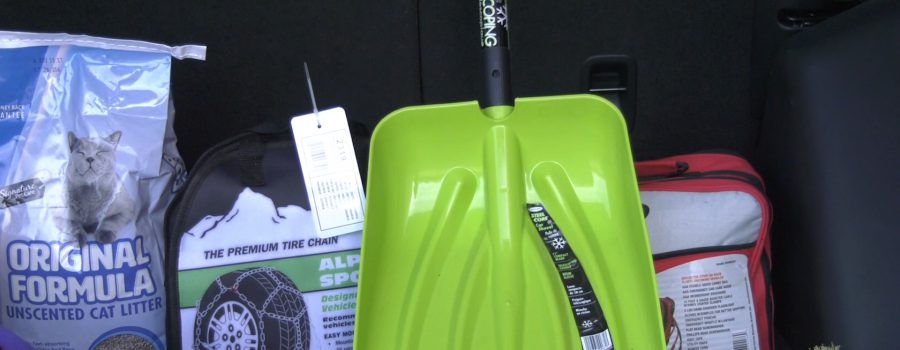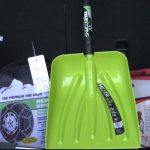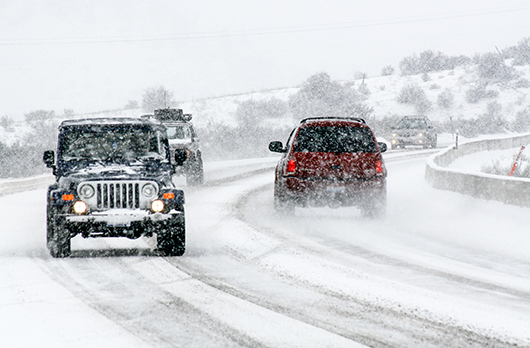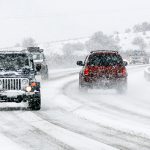Winter weather has arrived in Idaho and it’s time to be Idaho Ready on the road. One way you can do that? Keep an emergency kit in your car this winter.
https://www.youtube.com/watch?v=4KLR09HEuyM
You want to be prepared for anything that comes your way, so here are a few things you should always have with you when traveling.
- Flashlight — make sure the batteries work
- Jumper cables — in case your car won’t start, or maybe you need to help someone else
- Kitty litter can give you some traction if your tires are spinning on ice
- Chains
- Small shovel to dig out around your tires or tailpipe
- Flares and a first aid kit
- Food and water — pack high protein snacks that will fill you and your family up for a while
- Anything to keep you warm — a blanket or a small sleeping bag, winter coat, gloves, hat, and waterproof boots
- Ice scraper
If you run off the road, break down, or simply get stuck during a storm, these items will help keep you warm and safe until help arrives. Remember, always let someone know about your travel plans, especially if you’ll be driving through areas with no cell service. Check the latest road conditions at 511.idaho.gov before you leave.
Of the many things that Idahoans know a lot about, one of them is how to be prepared. Prepared for the big game, prepared for the campout, and prepared for the road. Whether you’ve lived in Idaho your whole life or are a new resident, it’s important to do everything you can to prepare for an Idaho winter. As the cold weather sets in, so do winter road conditions.
So how do you prepare for Idaho winter travel? We recommend starting by calling or visiting 511.idaho.gov to check road conditions and alerting friends and family of your travel plans (especially if you are traveling through areas with poor cellular service). Take time to review a map and make sure you know your path of travel as opposed to relying solely on GPS navigation which can occasionally be incorrect. Once you’ve checked those things off your list, ensure you are prepared for whatever comes your way by packing a winter car emergency kit.
Keeping a winter car emergency kit on hand won’t just benefit you, but it could come in handy for others you come across while traveling. Here are some items we recommend you include when building your winter car emergency kit:
- Flashlight with extra batteries to use as a light source and signal for help.
- Jumper cables to jump your own vehicle or assist other motorists.
- Tire pressure gauge to ensure you are driving with the optimum inflation.
- Cat litter to use as traction on slick surfaces.
- Small camping shovel to assist with removing snow around tires and tailpipes.
- LED flares to alert motorists of a broken down vehicle or roadway obstruction.
- First Aid Kit for minor injuries and emergencies.
- High protein food and bottled water to keep you hydrated and give you energy should you be stuck for a period of time. If your food items are in cans, make sure you also have necessary items like a can opener and utensils in your kit as well.
- Winter coats and gear such as hats, gloves, etc. to help keep your body temperature up.
- Blanket or a small sleeping bag for warmth in freezing conditions.
Some of the items may seem excessive but if you run off the road, breakdown or simply get stranded during an extreme storm, these items will help keep you warm and safe until roadside or emergency services are able to reach you.
For those that already have a winter car emergency kit in a vehicle, make sure you do an annual check of items to ensure they are in good condition and working order – remember, food expires and batteries don’t hold their charge forever. Also, if you do find yourself stuck in the snow, don’t run your vehicle without first ensuring the tailpipe and up to three feet behind your vehicle is free of snow; this, along with opening your windows, will prevent deadly carbon monoxide from building up inside the automobile.
As a parting note, be sure to replace worn windshield wipers, keep gas in your car and have the proper tires on before driving in winter weather conditions. Keeping all of that in mind, you’ll be well on your way to being prepared for an Idaho winter.




